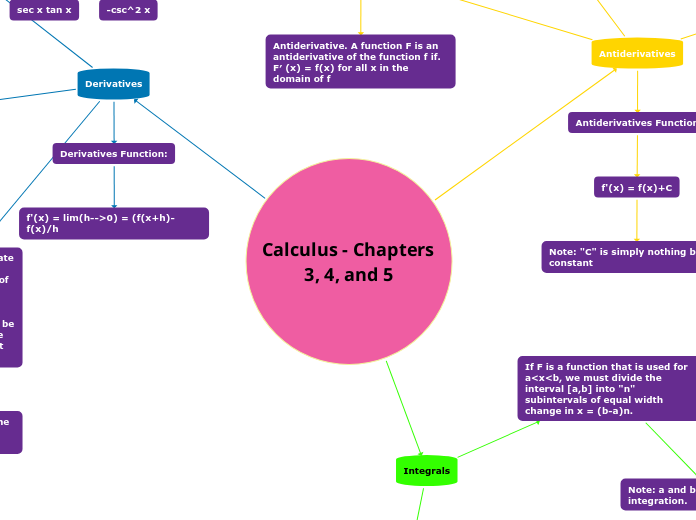Calculus - Chapters 3, 4, and 5
Integrals
Definite Integral and Indefinite Integral
An indefinite integral is defined as the internal which do not have limits applied to it and it gives a general solution for a problem
∫
Indefinite Integral Properties:
∫ 1 dx = x + C
∫ a dx = ax + C
∫ xn dx = ((xn+1)/(n+1)) + C ; n ≠ 1
∫ sin x dx = – cos x + C
∫ cos x dx = sin x + C
∫ sec2x dx = tan x + C
∫ cosec2x dx = -cot x + C
∫ sec x tan x dx = sec x + C
∫ cosec x cot x dx = -cosec x + C
∫ (1/x) dx = ln |x| + C
∫ ex dx = ex + C
∫ ax dx = (ax/ln a) + C ; a > 0, a ≠ 1
Function: ∫f(x) dx = F(x) + C
A definite integral is defined as the integral which has upper and lower limits and has a constant value as the solution
Function: ∫ab f(x) dx = F(b)-F(a)
Definite Integral properties:
∫ab f(x) dx = ∫ab f(t) d(t)
∫ab f(x) dx = – ∫ba f(x) dx
∫aa f(x) dx = 0
∫ab f(x) dx = ∫ac f(x) dx + ∫cb f(x) dx
∫ab f(x) dx = ∫ab f(a + b – x) dx
∫0a f(x) dx = f(a – x) dx
∫ab
If F is a function that is used for a
Note: a and be are the limits of integration.
Antiderivatives
Antiderivatives Function
f'(x) = f(x)+C
Note: "C" is simply nothing but a constant
Let F be an antiderivative of f over an interval I. Then,
for each constant C, the function F(x)+C is also an antiderivative of f over I. If G is an antiderivative of f over I, there is a constant C for which G(x)=F(x)+C over I.
In other words, the most general form of the antiderivative of f over I is F(x)+C.
It's basically like you're solving a derivatives backwards
A function F is an antiderivative of the function f if. F′ (x) = f(x) for all x in the domain of f
Antiderivative. A function F is an antiderivative of the function f if. F′ (x) = f(x) for all x in the domain of f
Derivatives
Differentiation Rules
Product rule
f′(x) = u′(x) × v(x) + u(x) × v′(x)
Quotient rule
f'(x) = (u'(x)*v(x)-u(x)*v'(x))/(v(x))^2
Chain rule
dy/dx = (dy/du) × (du/dx)
Difference rule
f'(x)=u'(x)-v'(x)
Sum rule
f'(x)=u'(x)+v'(x)
Trig Function
d/dx (cot x)
-csc^2 x
d/dx (sec x)
sec x tan x
d/dx (csc x)
-csc x cot x
d/dx (tan x)
sec^2 x
d/dx (cos x)
-sin x
d/dx (sin x)
cos x
Derivatives Function:
f'(x) = lim(h-->0) = (f(x+h)-f(x)/h
It refers to the instantaneous rate of change of a quantity with respect to the pther. The slope of the tangent line to a curve at a particular point on the curve. Since a curve represents a function, its derivative can also be thought of as the rate of change of the corresponding function at the given point.
When you find the derivative, the value of x gets smaller and smaller.

